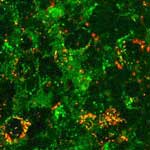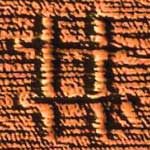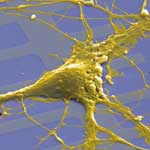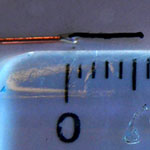Showing Spotlights 2193 - 2200 of 2785 in category All (newest first):
 Cells are the basic building blocks of life. The ability to sense and modify intracellular processes is important for, among other things, bettering our understanding of biological processes, developing drugs and evaluating their effectiveness, and modifying cell function. Due to the cell's small size and fragility, probing the cell's interior with high precision is not a simple task. To address this challenge, researchers have developed nanoscale, carbon-based cellular probes ('carbon nanopipettes' or CNP). The CNP consists of a glass capillary lined with a carbon film along its inner surface and terminating with an exposed carbon nanopipe. The probes are fabricated through a process that does not require any assembly and that facilitates quantity fabrication. Depending on controllable process conditions, the carbon tip's diameter may vary from tens to hundreds of nanometers and its length can range from zero to a few micrometers.
Cells are the basic building blocks of life. The ability to sense and modify intracellular processes is important for, among other things, bettering our understanding of biological processes, developing drugs and evaluating their effectiveness, and modifying cell function. Due to the cell's small size and fragility, probing the cell's interior with high precision is not a simple task. To address this challenge, researchers have developed nanoscale, carbon-based cellular probes ('carbon nanopipettes' or CNP). The CNP consists of a glass capillary lined with a carbon film along its inner surface and terminating with an exposed carbon nanopipe. The probes are fabricated through a process that does not require any assembly and that facilitates quantity fabrication. Depending on controllable process conditions, the carbon tip's diameter may vary from tens to hundreds of nanometers and its length can range from zero to a few micrometers.
Jul 8th, 2008
 Archaeological evidence indicates that ancient Chinese and Babylonian civilizations already were using fingerprints to sign legal documents as early as 1000 BCE. As early as 1880, Dr Henry Faulds, an English physician working in Tokyo, published a letter in the journal Nature suggesting the use of fingerprints for identification purposes. Today, fingerprints are still the primary method of identification of criminals although the techniques for fingerprint detection and enhancement have become hi-tech and involve nanotechnology applications. The most problematic of fingerprints are latent prints that are not readily visible and that require development by chemical and/or physical means. Usually, the choice of the technique for fingerprint development is dependent on the composition of latent fingerprints, on the type of substrate and on the ability of the technique to be applied in sequence in the context of the case. A new review paper describes the current status of nanotechnology-based techniques such as application of metal-containing nanoparticles and nano-structured particles to fingermark detection. It concluds that nanotechnology is likely to play a major role in the future to deliver more selective and more sensitive ways to detect and enhance fingermarks.
Archaeological evidence indicates that ancient Chinese and Babylonian civilizations already were using fingerprints to sign legal documents as early as 1000 BCE. As early as 1880, Dr Henry Faulds, an English physician working in Tokyo, published a letter in the journal Nature suggesting the use of fingerprints for identification purposes. Today, fingerprints are still the primary method of identification of criminals although the techniques for fingerprint detection and enhancement have become hi-tech and involve nanotechnology applications. The most problematic of fingerprints are latent prints that are not readily visible and that require development by chemical and/or physical means. Usually, the choice of the technique for fingerprint development is dependent on the composition of latent fingerprints, on the type of substrate and on the ability of the technique to be applied in sequence in the context of the case. A new review paper describes the current status of nanotechnology-based techniques such as application of metal-containing nanoparticles and nano-structured particles to fingermark detection. It concluds that nanotechnology is likely to play a major role in the future to deliver more selective and more sensitive ways to detect and enhance fingermarks.
Jul 7th, 2008
 The challenge in treating most brain disorders is overcoming the difficulty of delivering therapeutic agents to specific regions of the brain by crossing the blood-brain barrier (BBB). This barrier - a tight seal of endothelial cells that lines the blood vessels in the brain - is a physiological checkpoint that selectively allows the entry of certain molecules from blood circulation into the brain. The problem for scientists is that the BBB does not differentiate what it keeps out. BBB strictly limits transport into the brain through both physical (tight junctions) and metabolic (enzymes) barriers. With very few exceptions, only nonionic and low molecular weight molecules soluble in fat clear the BBB. For instance, alcohol, caffeine, nicotine and antidepressants meet these criteria. However, large molecules needed to deliver drugs do not. The utter scarcity of techniques for brain-specific delivery of therapeutic molecules using non-invasive approaches (like drilling a hole in the skull) has led researchers to increasingly explore the vast potential of nanotechnology toward the diagnosis and treatment of diseases/disorders incurable with present techniques.
The challenge in treating most brain disorders is overcoming the difficulty of delivering therapeutic agents to specific regions of the brain by crossing the blood-brain barrier (BBB). This barrier - a tight seal of endothelial cells that lines the blood vessels in the brain - is a physiological checkpoint that selectively allows the entry of certain molecules from blood circulation into the brain. The problem for scientists is that the BBB does not differentiate what it keeps out. BBB strictly limits transport into the brain through both physical (tight junctions) and metabolic (enzymes) barriers. With very few exceptions, only nonionic and low molecular weight molecules soluble in fat clear the BBB. For instance, alcohol, caffeine, nicotine and antidepressants meet these criteria. However, large molecules needed to deliver drugs do not. The utter scarcity of techniques for brain-specific delivery of therapeutic molecules using non-invasive approaches (like drilling a hole in the skull) has led researchers to increasingly explore the vast potential of nanotechnology toward the diagnosis and treatment of diseases/disorders incurable with present techniques.
Jul 3rd, 2008
 Elastomeric (i.e. elastic) proteins are able to withstand significant deformations without rupture before returning to their original state when the stress is removed. Consequently, these proteins confer excellent mechanical properties to many biological tissues and biomaterials. Depending on the role performed by the tissue or biomaterial, elastomeric proteins can behave either as springs or shock absorbers. Recent scientific work in Canada resulted in the engineering of the first artificial chameleon elastomeric proteins that mimic and combine these two different behaviors into one protein. Under the regulation of a molecular regulator, these designer proteins exhibit one of the two distinct mechanical behaviors - spring or shock absorber - which closely mimic the two extreme behaviors observed in naturally occurring elastomeric proteins.
Elastomeric (i.e. elastic) proteins are able to withstand significant deformations without rupture before returning to their original state when the stress is removed. Consequently, these proteins confer excellent mechanical properties to many biological tissues and biomaterials. Depending on the role performed by the tissue or biomaterial, elastomeric proteins can behave either as springs or shock absorbers. Recent scientific work in Canada resulted in the engineering of the first artificial chameleon elastomeric proteins that mimic and combine these two different behaviors into one protein. Under the regulation of a molecular regulator, these designer proteins exhibit one of the two distinct mechanical behaviors - spring or shock absorber - which closely mimic the two extreme behaviors observed in naturally occurring elastomeric proteins.
Jul 2nd, 2008
 The reduction of linewidth is one of the most important problems in integrated circuit (IC) technology because the speed and performance of computer chips is dictated by the lithographic minimum printable size. In the early 1960s, ICs had a linewidth of about 5 micrometers. Dramatic improvements in optical lithography technology has brought this down to the limits allowed by the wavelength of light that is used in the process. Current state-of-the-art photolithography tools use deep ultraviolet light with wavelengths of 248 and 193 nm, which theoretically allow minimum feature sizes down to 50 nm. But even the shortest UV wavelength currently in use (157 nm) does not provide the resolution required by the ever decreasing feature sizes of state-of-the-art nanomanufacturing processes. Researchers in Israel have been working on the use of laser ablation to write very small features - much smaller than the optical wavelength - on the surface of different materials. They have now demonstrated floating tip nanolithography, a high quality non-contact surface modification with high spatial resolution within a commercial atomic force microscope.
The reduction of linewidth is one of the most important problems in integrated circuit (IC) technology because the speed and performance of computer chips is dictated by the lithographic minimum printable size. In the early 1960s, ICs had a linewidth of about 5 micrometers. Dramatic improvements in optical lithography technology has brought this down to the limits allowed by the wavelength of light that is used in the process. Current state-of-the-art photolithography tools use deep ultraviolet light with wavelengths of 248 and 193 nm, which theoretically allow minimum feature sizes down to 50 nm. But even the shortest UV wavelength currently in use (157 nm) does not provide the resolution required by the ever decreasing feature sizes of state-of-the-art nanomanufacturing processes. Researchers in Israel have been working on the use of laser ablation to write very small features - much smaller than the optical wavelength - on the surface of different materials. They have now demonstrated floating tip nanolithography, a high quality non-contact surface modification with high spatial resolution within a commercial atomic force microscope.
Jul 1st, 2008
 Bionics - a word formed from biology and electronics - has become a quickly expanding research field, exploring ways and materials to bridge the interface between electronics and biology. Basically, there are three levels of biocommunications where electronics and biology could interface: molecular, cellular and skeletal. For any implanted bionic material it is the initial interactions at the biomolecular level that will determine longer term performance. While bionics is often associated with skeletal level enhancements, electronic communication with living cells is of interest with a view to improving the results of tissue engineering or the performance of implants such as bionic ears or eyes. Researchers have worked for more than 20 years on interfacing neurons and silicon devices. Analysis of the electro-physiological activity of neurons could one day enable scientists to develop artificial prostheses for bypassing injured zones and restore brain functionality, or to realize neuro-diagnostic tools for monitoring the reaction of biological neurons to selected chemical species or newly developed drugs. Making another step in this direction, researchers in Europe have now demonstrated the possibility of integrating living neural cells and organic semiconductor thin-films made of a few monolayers of pentacene.
Bionics - a word formed from biology and electronics - has become a quickly expanding research field, exploring ways and materials to bridge the interface between electronics and biology. Basically, there are three levels of biocommunications where electronics and biology could interface: molecular, cellular and skeletal. For any implanted bionic material it is the initial interactions at the biomolecular level that will determine longer term performance. While bionics is often associated with skeletal level enhancements, electronic communication with living cells is of interest with a view to improving the results of tissue engineering or the performance of implants such as bionic ears or eyes. Researchers have worked for more than 20 years on interfacing neurons and silicon devices. Analysis of the electro-physiological activity of neurons could one day enable scientists to develop artificial prostheses for bypassing injured zones and restore brain functionality, or to realize neuro-diagnostic tools for monitoring the reaction of biological neurons to selected chemical species or newly developed drugs. Making another step in this direction, researchers in Europe have now demonstrated the possibility of integrating living neural cells and organic semiconductor thin-films made of a few monolayers of pentacene.
Jun 30th, 2008
 In recent years, great progress has been made in the synthesis and application studies of hybrid nanomaterial systems involving carbon nanotubes (CNTs). Efforts involve the alteration of physical properties of CNTs via the use of organic, inorganic, and biological species to produce functionalized CNTs for further applications. In one such hybrid system, aligned CNT templates serve as a natural 3D scaffold ('CNT forests'). Preferential assembly of nanoparticles onto targeted locations in this 3D scaffold creates novel hybrid nanomaterial systems with a unique architecture comprised of different functional components. For example, these CNT forests could serve as a template for controlled assembly of various semiconducting nanoparticles such as quantum dots. The resulting hybrid nanomaterial has the effect of changing both optical and electronic properties of the CNTs.
In recent years, great progress has been made in the synthesis and application studies of hybrid nanomaterial systems involving carbon nanotubes (CNTs). Efforts involve the alteration of physical properties of CNTs via the use of organic, inorganic, and biological species to produce functionalized CNTs for further applications. In one such hybrid system, aligned CNT templates serve as a natural 3D scaffold ('CNT forests'). Preferential assembly of nanoparticles onto targeted locations in this 3D scaffold creates novel hybrid nanomaterial systems with a unique architecture comprised of different functional components. For example, these CNT forests could serve as a template for controlled assembly of various semiconducting nanoparticles such as quantum dots. The resulting hybrid nanomaterial has the effect of changing both optical and electronic properties of the CNTs.
Jun 27th, 2008
 Carbon nanotubes (CNTs) have been widely used as electrodes for chemical and biological sensing applications and many other electrochemical studies. With their unique one-dimensional molecular geometry of a large surface area coupled with their excellent electrical properties, CNTs have become important materials for the molecular engineering of electrode surfaces where the development of electrochemical devices with region-specific electron-transfer capabilities is of paramount importance. It has been demonstrated that carbon nanotubes enhance the electrochemical activity of biomolecules and promote the electron-transfer reactions of redox proteins, such as myoglobin, cyctochrome c, and microperoxidase MP-11. The enhanced electrochemical activity and electron transfer rate at CNT electrodes have been widely believed to arise from the nanotube tips. However, no convincing experimental evidence has been obtained to prove that the CNT tip is more electrochemically active than its sidewall. Contradicting this common belief, researchers have now found that, surprisingly, the electrochemistry at carbon nanotube electrodes is not always facilitated by the nanotube tip. In fact, the relative electrochemical sensitivity of the nanotube tip and sidewall varies for different electrochemical probes proceeding with different reaction mechanisms.
Carbon nanotubes (CNTs) have been widely used as electrodes for chemical and biological sensing applications and many other electrochemical studies. With their unique one-dimensional molecular geometry of a large surface area coupled with their excellent electrical properties, CNTs have become important materials for the molecular engineering of electrode surfaces where the development of electrochemical devices with region-specific electron-transfer capabilities is of paramount importance. It has been demonstrated that carbon nanotubes enhance the electrochemical activity of biomolecules and promote the electron-transfer reactions of redox proteins, such as myoglobin, cyctochrome c, and microperoxidase MP-11. The enhanced electrochemical activity and electron transfer rate at CNT electrodes have been widely believed to arise from the nanotube tips. However, no convincing experimental evidence has been obtained to prove that the CNT tip is more electrochemically active than its sidewall. Contradicting this common belief, researchers have now found that, surprisingly, the electrochemistry at carbon nanotube electrodes is not always facilitated by the nanotube tip. In fact, the relative electrochemical sensitivity of the nanotube tip and sidewall varies for different electrochemical probes proceeding with different reaction mechanisms.
Jun 26th, 2008
 Cells are the basic building blocks of life. The ability to sense and modify intracellular processes is important for, among other things, bettering our understanding of biological processes, developing drugs and evaluating their effectiveness, and modifying cell function. Due to the cell's small size and fragility, probing the cell's interior with high precision is not a simple task. To address this challenge, researchers have developed nanoscale, carbon-based cellular probes ('carbon nanopipettes' or CNP). The CNP consists of a glass capillary lined with a carbon film along its inner surface and terminating with an exposed carbon nanopipe. The probes are fabricated through a process that does not require any assembly and that facilitates quantity fabrication. Depending on controllable process conditions, the carbon tip's diameter may vary from tens to hundreds of nanometers and its length can range from zero to a few micrometers.
Cells are the basic building blocks of life. The ability to sense and modify intracellular processes is important for, among other things, bettering our understanding of biological processes, developing drugs and evaluating their effectiveness, and modifying cell function. Due to the cell's small size and fragility, probing the cell's interior with high precision is not a simple task. To address this challenge, researchers have developed nanoscale, carbon-based cellular probes ('carbon nanopipettes' or CNP). The CNP consists of a glass capillary lined with a carbon film along its inner surface and terminating with an exposed carbon nanopipe. The probes are fabricated through a process that does not require any assembly and that facilitates quantity fabrication. Depending on controllable process conditions, the carbon tip's diameter may vary from tens to hundreds of nanometers and its length can range from zero to a few micrometers.
 Subscribe to our Nanotechnology Spotlight feed
Subscribe to our Nanotechnology Spotlight feed





